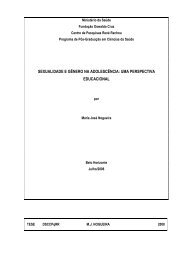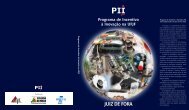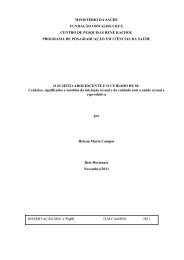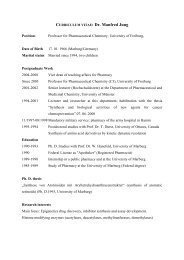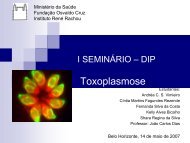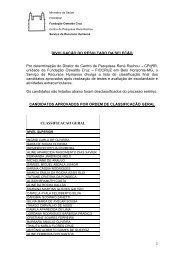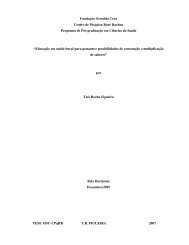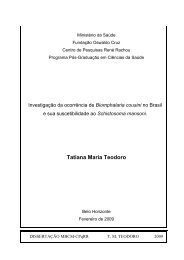Hanseníase: políticas públicas e qualidade de vida de - Centro de ...
Hanseníase: políticas públicas e qualidade de vida de - Centro de ...
Hanseníase: políticas públicas e qualidade de vida de - Centro de ...
Create successful ePaper yourself
Turn your PDF publications into a flip-book with our unique Google optimized e-Paper software.
Abstract<br />
Leprosy is a reportable disease that is inclu<strong>de</strong>d in the list of neglected and stigmatizing<br />
diseases. The stigma of the disease results from the translation of the biblical word tsaraath<br />
that brought to Western culture a charge of beliefs about divine sentence, punishment and sin,<br />
that influenced the medieval Europe’s cruel manner to <strong>de</strong>al with the disease. Since the<br />
fifteenth century, leprosy becomes a mainly a colonial disease, reducing dramatically in<br />
Europe due to the improvement of sanitary conditions. At the end of the nineteenth century,<br />
the discovery of the bacillus of Hansen brougth a scientifically based justification for the<br />
isolation of patients, a fact that will influence the way that Brazilian public health will <strong>de</strong>al<br />
with the disease.<br />
In this dissertation, the objective was to contextualize the public policies adopted, and the<br />
role of Hansen's disease in quality of life of caregivers and people living with its<br />
consequences.<br />
It was conducted a review of the literature concerning the history of public policies to fight<br />
against leprosy / Hansen's disease, with consultation of primary sources, scientific papers,<br />
and secondary sources, websites and e-books. It was held concurrently a review of the<br />
medical literature for scientific information on caregivers and quality of life (QoL).<br />
Intelligence were collected from patients about socio<strong>de</strong>mographic data, clinical data,<br />
autonomy and cognition; to the caregivers there were collected <strong>de</strong>mographic data and data<br />
about care. It was applied Minimental and questionnaires assessing activities of life to<br />
patients, and the WHOQOL-brief questionnaire to patients and caregivers.<br />
Brazillian public policies concerning leprosy started only in the twentieth century,<br />
caracterized by isolation and segregation of patients, adopting a mo<strong>de</strong>l initially created in Sao<br />
Paulo state since the Getúlio Varga´s government, based on the “anti-leprotic tripod”:<br />
leprosariums, preventoriums and dispensaries. This mo<strong>de</strong>l would last even after the discovery<br />
of treatment with sulfones, and would prove ineffective both for prophylaxis, and for healing<br />
the sick, causing physical and psychological sequelae with serious consequences for the<br />
isolated patients. The statistical analysis of the patient-caregiver binomial showed the lowest<br />
scores for quality of life for patients in the physical and mental, with better scores for the<br />
social domain WHOQoL. Caregivers had lower scores than the patients in the social domain,<br />
and higher in the physical domain, with no difference in the environment and psychic<br />
domains. The univariate linear regression analysis showed significant correlations: the<br />
presence of a companion, pacient’s autonomy and caregiver's age influenced the patient's<br />
QoL. For the caregiver, clinical and patient autonomy influenced the environment and social<br />
domains, and caregiver's own data influenced the psychic domain. The peculiarities of the<br />
isolation and stigma were <strong>de</strong>terminative in both. The patient who has exposed its sequels and<br />
the external environment has lowest scores of quality of life, and widowhood is associated<br />
with better QoL scores because of gaining financial and patriarchal in<strong>de</strong>pen<strong>de</strong>nce and<br />
because of the social network formed. For caregivers, the patient’s use of wheelchair<br />
generates less overhead due to clinical improvement after amputation, but the particularities<br />
of patient autonomy generate QoL scores that are directly impacted by the natural evolution<br />
and the consequences of leprosy. In short, the isolation in Leprosarium was responsible for<br />
the emergence of physical and emotional consequences with a negative impact on QoL of the<br />
binomial patient-caregiver, but the resilience mediated by a social network, augmented by an<br />
entity of social support (MORHAN) plays an important role in QoL, particularly in the social<br />
domain. The analysis also <strong>de</strong>monstrated that the correlations between autonomy and quality<br />
of life does not have a linear relationship, indicating the need for further studies to suggest<br />
ways in which the transition from in<strong>de</strong>pen<strong>de</strong>nce to <strong>de</strong>pen<strong>de</strong>nce, especially in the el<strong>de</strong>rly,<br />
being the population of leprosy patients also influenced by local peculiarities.<br />
XVII



